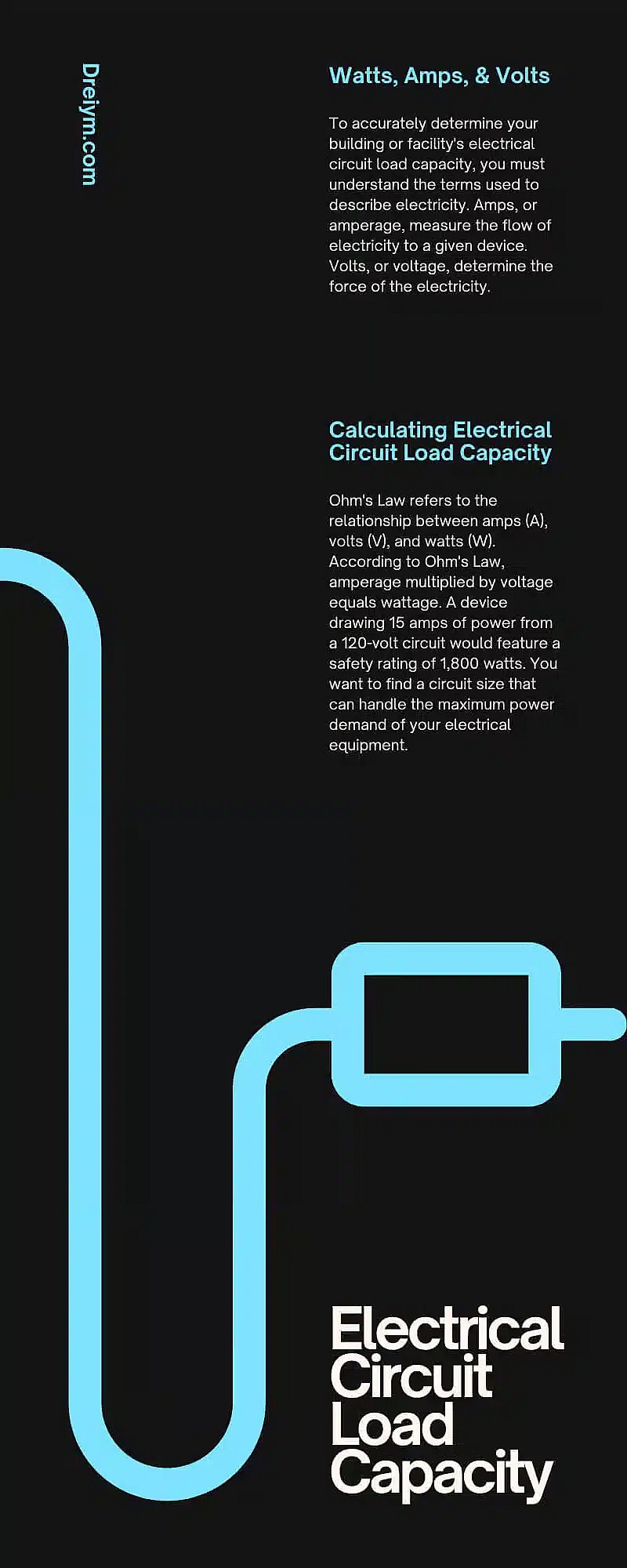How To Calculate Electrical Circuit Load Capacity
Are you looking to boost your electrical equipment’s performance and safety rating? To achieve the ideal electrical supply for your commercial building, it’s essential that you understand the basics of, and how to calculate electrical circuit load capacity. This information ensures that you, your building, and the employees inside remain protected from the dangers of short-circuiting electrical equipment.
Luckily, correctly determining the load capacity for your devices and building is quite simple and merely requires some background into how we measure and describe electricity. Read on to learn more about the proper ways to determine the load capacity of your circuits.
The Importance of Understanding Electrical Circuit Load Capacity
We cannot understate the importance of understanding electrical circuit load capacity, especially as a business owner or building manager. By properly calculating your building’s load capacity, you can choose an appropriate electrical service and reduce the risk of short-circuiting, electrical fires, and other workplace hazards. But what exactly is electrical circuit load capacity? This term refers to the maximum level of electrical current your building (or, more specifically, the electronic appliances and devices within the building) can safely withstand.
And while most buildings and facilities spend money and effort on improving the technology within the business, they often forget to upgrade the systems responsible for electrical output throughout the building. As a result, these older buildings lack the proper electrical infrastructure to power modern devices safely and effectively. However, investing in a new main source of energy and electricity for your business isn’t enough – you must know your equipment’s exact electrical circuit load capacity.
As stated before, this information helps protect you, your building, and the people working inside from electrical fires and other accidents. Additionally, the dangers of short-circuiting impact your finances, as they can cause irreparable damage to expensive appliances and electronic devices. Furthermore, the risk of electric shock is significantly increased. Finally, not providing your building with the appropriate electrical current places more liability on your business in the event of structural damages, injury, or death.
Watts, Amps, & Volts
To accurately determine your building or facility’s electrical circuit load capacity, you must understand the terms used to describe electricity. Amps, or amperage, measure the flow of electricity to a given device. Volts, or voltage, determine the force of the electricity. When multiplied together, volts and amps produce watts or wattage. Watts refers to the rate of electrical energy transferring within a circuit. Increasing the voltage (volts) and current (amps) subsequently increases power (watts).
Every electrical device has a limit to the wattage it can safely consume. For instance, incandescent light bulbs use anywhere from 25-100 watts, while LEDs consume up to 18 watts. Now, consider all of the light bulbs within a commercial building, along with countless other electrical devices such as air conditioning systems, appliances, entertainment equipment, and more – they all require a lot of wattage. Commercial buildings often require 50 kilowatts + five watts per square foot. However, this number ultimately depends on the electrical circuit load capacity of the equipment inside the building.
Considering there are so many electrical devices to worry about in one building, the thought of accurately determining the best electrical services can sound daunting. Knowing what watts, amps, and volts are doesn’t mean you can calculate true electrical circuit load capacities – right? Wrong! Understanding these three terms is practically all you need to measure load capacity effectively.
Calculating Electrical Circuit Load Capacity
Calculating the electrical circuit load capacity for one electrical device is quite simple, thanks to Ohm’s Law. Ohm’s Law refers to the relationship between amps (A), volts (V), and watts (W). According to Ohm’s Law, amperage multiplied by voltage equals wattage. A device drawing 15 amps of power from a 120-volt circuit would feature a safety rating of 1,800 watts. You want to find a circuit size that can handle the maximum power demand of your electrical equipment.
However, these calculations are a bit tricker when including all of the circuits in your building, especially extension cords and outlets. Overloading an outlet with devices that exceed the load capacity of the circuit is more likely to cause a short circuit. As such, it’s recommended that you utilize Ohm’s Law to find an appropriate circuit size for all your electronic devices and equipment, ensuring you leave a 20 percent safety margin.
If a specific set of devices requires 1,800 watts, your outlet or extension cords must have a 20-amp circuit capable of providing 2,400 watts. This leaves enough room for error and ensures that devices receive adequate power without the risk of failure. Of course, this example is very small-scale – most commercial facilities and buildings require kilowatts of power. However, Ohm’s Law dictates that the equation used to calculate proper electrical circuit load capacity is always consistent, regardless of scale.
Seeking Professional Help
While the equation for determining electrical circuit load capacity is relatively simple, conducting a proper electrical load analysis requires professional services. That’s where we at Dreiym come in to help! We offer electrical circuit load capacity analysis services to ensure your electrical system is adequately balanced.
Using this gathered information, we can work with your business to update your building’s systems accordingly and even troubleshoot when problems present themselves. Additionally, we can assist in the growth of your business and its electrical system. Ultimately, hiring a professional analysis is always a wise decision, especially when ensuring the safety of your employees, yourself, and your facility.
Electrical systems are confusing and complex, requiring some background knowledge when conducting tests. Luckily, the responsibility of knowing your building’s load capacity doesn’t have to be scary. Now that you understand how to calculate electrical circuit load capacity, you can hire the very best analysis services for your building.
Contact our friendly team at Dreiym Engineering today – we’re eager to work with your specific needs to ensure a safe and successful working environment. We’re also happy to answer any questions regarding electrical circuit load capacity, our services, and related concerns!













































